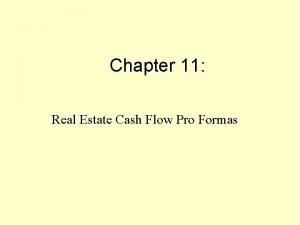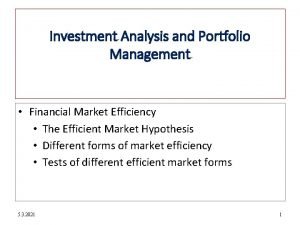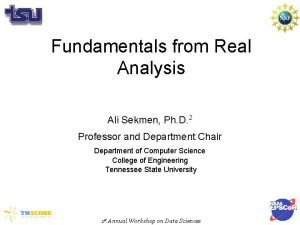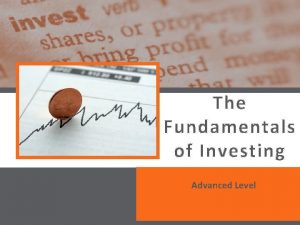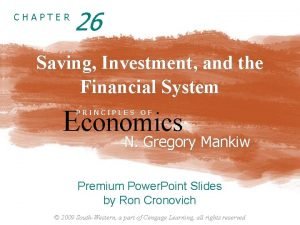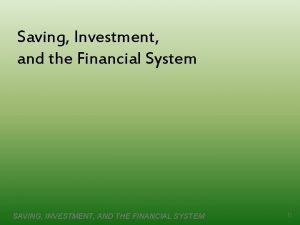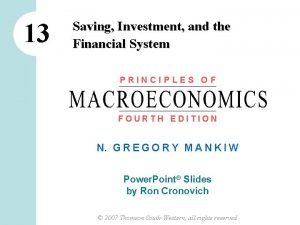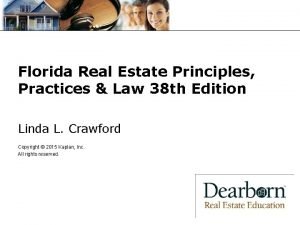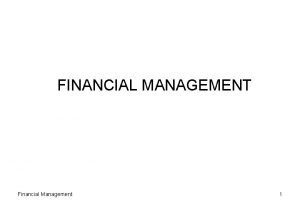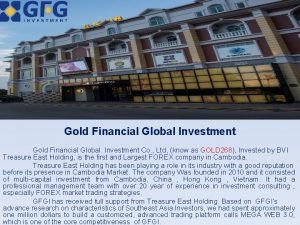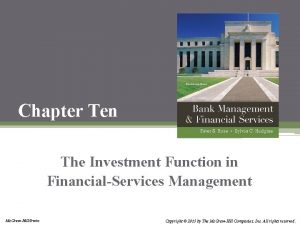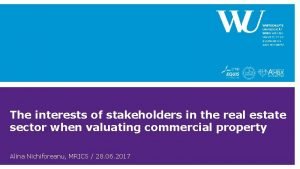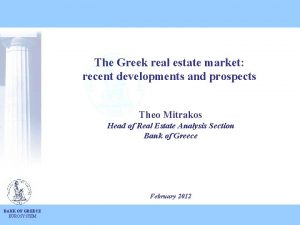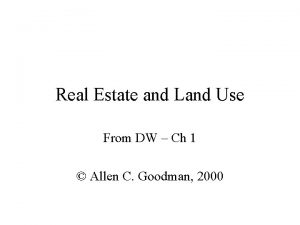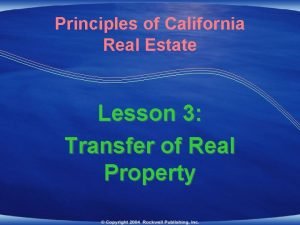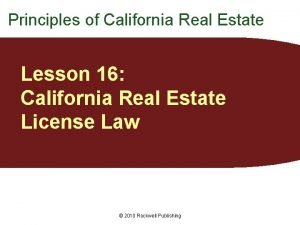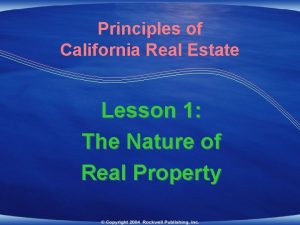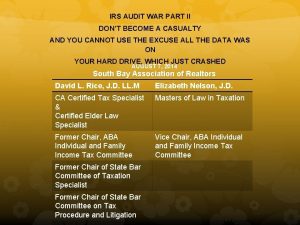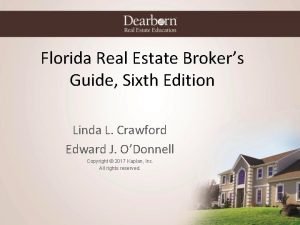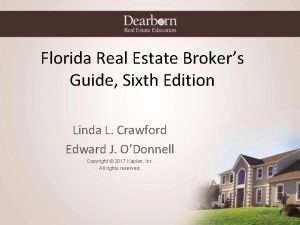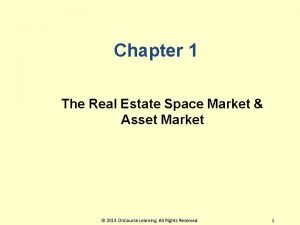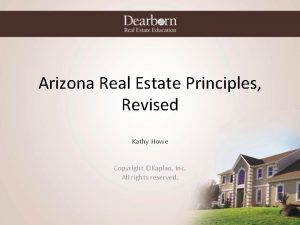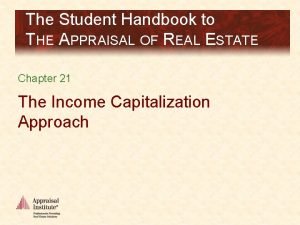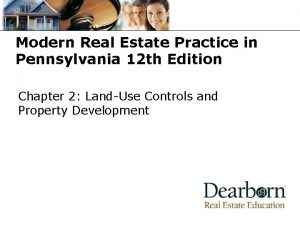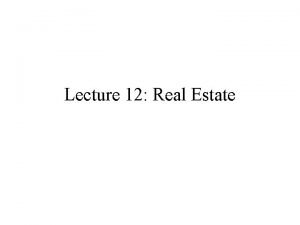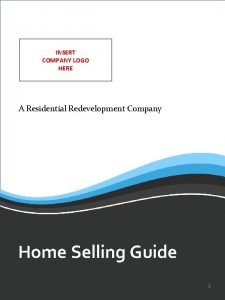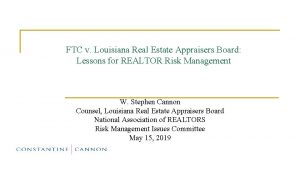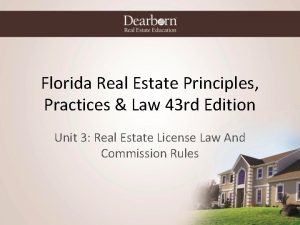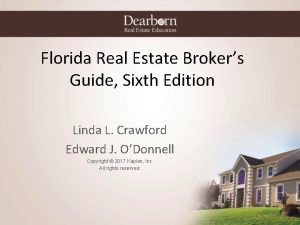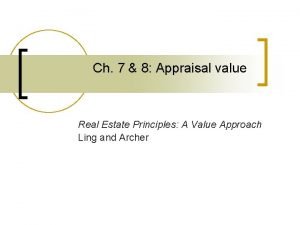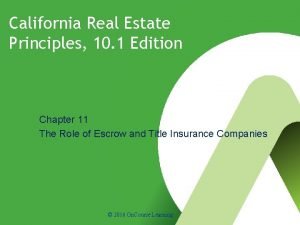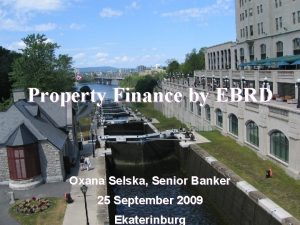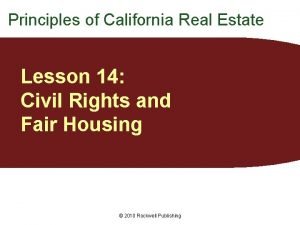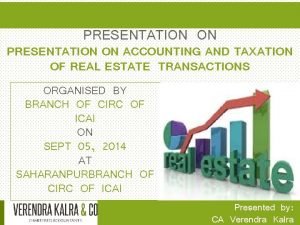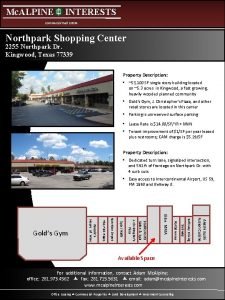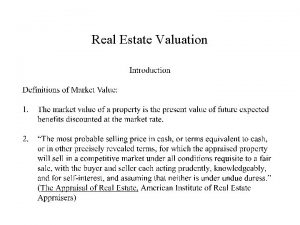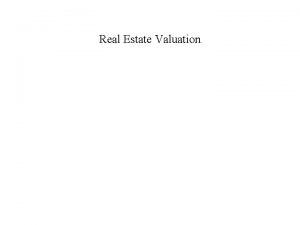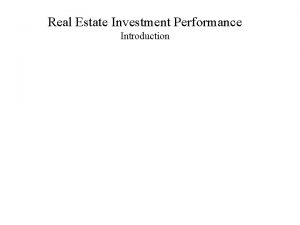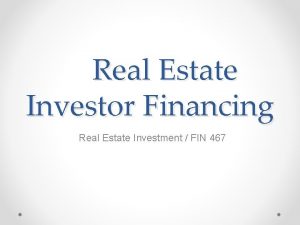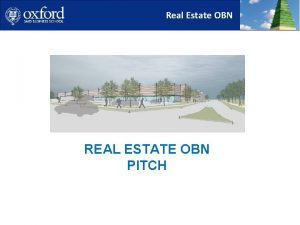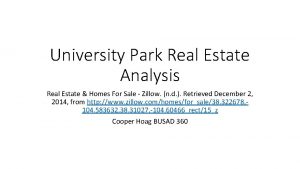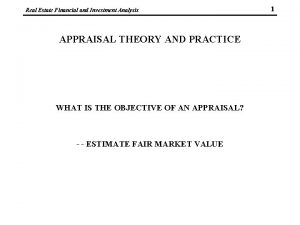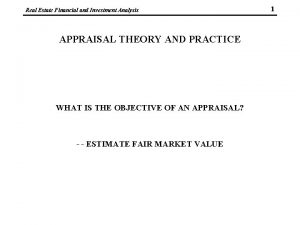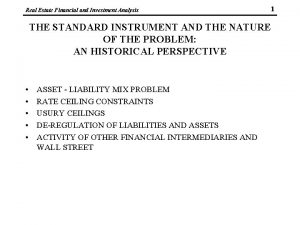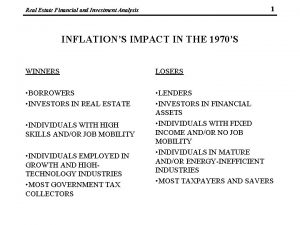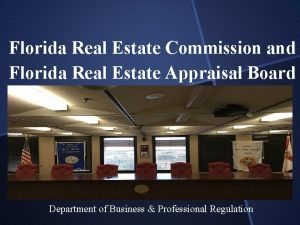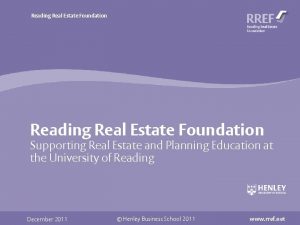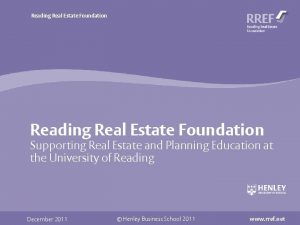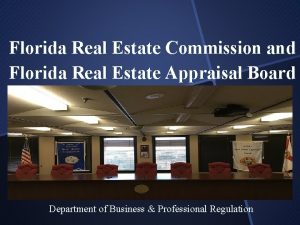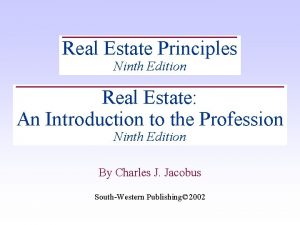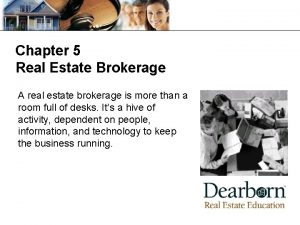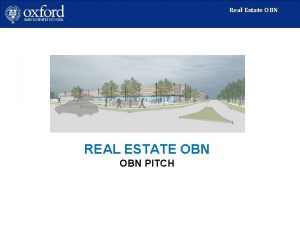Real Estate Financial and Investment Analysis 1 FUNDAMENTALS






































































- Slides: 70

Real Estate Financial and Investment Analysis 1 FUNDAMENTALS OF PROJECT FINANCIAL AND INVESTMENT ANALYSIS This presentation will lay the groundwork for the remainder of the course, reviewing basic principles of finance as they relate to real estate project financialinvestment analysis and evaluation. There will be four sessions: I. Structuring a real estate feasibility analysis II. Evaluating the risk/return tradeoff for real estate projects III. Developing techniques of financial analysis IV. Examining problems and pitfalls of financial investment analysis.

Real Estate Financial and Investment Analysis 2 I. STRUCTURING A REAL ESTATE FEASIBILITY ANALYSIS This introductory session will address the concept of feasibility and real estate investment analysis; development of the first-year pro forma; and the usefulness of the CAP rate.

3 Real Estate Financial and Investment Analysis Yes, Virginia there are only three things that matter in real estate. . . LOCATION! L x L REGIONAL FACTORS NEIGHBORHOOD SITE-SPECIFIC & ELEMENTS FEATURES MACROECONOMIC CIRCUMSTANCES

Real Estate Financial and Investment Analysis OUTLINE OF A FEASIBILITY STUDY 1. Site Analysis • Survey of site to determine net useable land area • Zoning of site and related constraints • Availability of utilities to site • Subsurface soil conditions • Preliminary title report, CC & Rs 2. Initial Concept • Establish target land development concept in terms of developer’s goals, permitted zoning, and developer’s financial resources 4

Real Estate Financial and Investment Analysis 5 OUTLINE OF A FEASIBILITY STUDY 3. Demand Analysis • Evaluate the economic base that supports the community in which project is located: – Population projections – Employment projections – Income Projections • Study the demand forces that pertain to your specific project type • Analyze the competitive market within which you must operate 4. Supply Analysis • Determine market area related to project • Analyze the present and future inventory of product that you will be competing with in relation to your delivery date • Determine product mix in relation to competitive rents, pricing, and amenities

Real Estate Financial and Investment Analysis OUTLINE OF A FEASIBILITY STUDY 5. Specific Development Scheme • With architects and engineers, developer relates concept to market conditions, with a specific development scheme, land use plan 6. Cost Estimates • Based on a specific plan, developer then estimate all hard and soft costs based on the “bid date” of the project 6

Real Estate Financial and Investment Analysis OUTLINE OF A FEASIBILITY STUDY 7. Financial Structure • Reviews profitability for go/no go decisions • Review mortgage loan ratios, terms of borrowing, equity position, tax considerations • Determine phasing, if any, and absorption rates 8. Rate of Return Analysis • Review risk factors related to project • Review length of investment period • Determine rate of return “on” and “of” the investment 7

Real Estate Financial and Investment Analysis WILSHIRE BOULEVARD OFFICE BUILDING Building Synopsis • Gross building area 205, 000 sq. ft. • Net leasable area 176, 000 sq. ft. (86%) • Parking structure 427 cars 8

9 Real Estate Financial and Investment Analysis WILSHIRE BOULEVARD OFFICE BUILDING Direct Costs • Office building: 205, 000 sq. ft. at $43/sq. ft. • Parking structure – Above grade: 22, 420 sq. ft. at $24/sq. ft. • • • – Below grade: 125, 000 sq. ft. at $28/sq. ft. Tenant improvements: 176, 000 sq. ft. at $11/sq. ft. Site development Architectural & Engineering • – 6% of hard costs ($14, 984, 000) Contingency – 5% of $15, 883, 040 TOTAL $8, 815, 000 538, 000 3, 511, 000 1, 936, 000 84, 000 889, 040 794, 152 $16, 667, 192

10 Real Estate Financial and Investment Analysis WILSHIRE BOULEVARD OFFICE BUILDING Indirect Costs • Real estate taxes • • • TOTAL – 1% of direct cost plus land; 15 mos. /2 Permits, legal fees, title, escrow, insurance Development fee: 3% of hard costs Leasing commission: 3% on $22 x 176, 000 x 5 years Lease-up expense: $4/sq. ft. x 176, 000 sq. ft. for 6 mos. Consulting fee $123, 000 150, 000 500, 015 580, 800 352, 000 150, 000 $1, 855, 815

11 Real Estate Financial and Investment Analysis WILSHIRE BOULEVARD OFFICE BUILDING TOTAL DIRECT AND INDIRECT COSTS $18, 523, 007 Financing cost: 16% for 15 mos. /2 on total costs & financing cost ($20, 581, 119) 2, 058, 112 Land 3, 000 TOTAL COST INCLUDING FINANCING $23, 581, 119

Real Estate Financial and Investment Analysis WILSHIRE BOULEVARD OFFICE BUILDING FULL-YEAR OPERATING PRO FORMA 12

Real Estate Financial and Investment Analysis 13 BASIC ACCOUNTING FOR INCOME PROPERTIES GROSS POSSIBLE INCOME (GPI) - VACANCY AND BAD DEBT FACTOR EFFECTIVE GROSS INCOME (EGI) - OPERATING EXPENSES NET OPERATING INCOME (NOI) OR NET EFFECTIVE INCOME - DEBT SERVICE CASH FLOW BEFORE TAXES (CFBT) - NET TAXES* NET SPENDABLE INCOME (NSI) * CFBT + Principal Paydowns - Depreciation = TAXABLE INCOME

Real Estate Financial and Investment Analysis THE CAP RATE CONCEPT 14

15 Real Estate Financial and Investment Analysis GRAPHIC INTERPRETATION OF CAP RATE MV=(1/k)NOI MV NOI

Real Estate Financial and Investment Analysis WHAT THE CAP RATE MUST TAKE INTO ACCOUNT 1. Riskless Rate of Return • real return • inflationary adjustment 2. Liquidity 3. Management Return 4. Parcel Specificity Risk 16

Real Estate Financial and Investment Analysis HOW TO CHOOSE THE CORRECT CAP RATE How do you know what the correct capitalization rate is? Only by knowing intimately every feature of the property you are considering, along with the basic factors touched upon above: • Investor demand for and the existing supply of the particular type of property • Stability and security of future income • Capitalization rates of price earning ratios of alternate, non-real estate investments with comparable risk. 17

Real Estate Financial and Investment Analysis 18 DETERMINING RISK AND DEMAND The investor can determine risk and demand as it affects the CAP rate by carefully examining the property’s features: 1. Exact Location In the main business district, for example, even a few feet may make one location better than another. Access to mass transportation becomes increasingly important as the costs of private transportation and/or regulations become increasingly higher. 2. Age of the Building The older the building, the less future income can be derived from it in its present state. 3. Size of the Land Parcel

Real Estate Financial and Investment Analysis 19 DETERMINING RISK AND DEMAND 4. Quality of the Tenancies For example, other things being equal, a long-term lease represents more stable value than a short-term lease (e. g. , hotel/motel room rentals are far less secure than apartment building leases). 5. Existing Financing on the Property Even between properties of otherwise equal investment value, better financing on one may give it an apparently lower CAP rate. 6. Operating Costs Pay particular attention to higher energy costs for heating and air conditioning. In any comparison of buildings for investment purposes, the type of construction (glass walls, for example) can have an important bearing on those costs. Labor costs and the likelihood of continued increases also need to be considered.

Real Estate Financial and Investment Analysis EXCEL SPREAD SHEET AND CHART INSERTS PP 16 - 22 20

Real Estate Financial and Investment Analysis 21 II. EVALUATING THE RISK-RETURN TRADEOFF FOR A REAL ESTATE PROJECT Now we will address the generation of the discounted cash flow, and take a first cut at financial ratio analysis.

Real Estate Financial and Investment Analysis DISCOUNTED CASH FLOW MODELS I. DCF Model-Basic Data Requirements A. Investment outlays • land costs • building costs • depreciation method • useful life B. Operational characteristics • rental income • vacancy and collection factors • operating expenses • changes over time 22

Real Estate Financial and Investment Analysis DISCOUNTED CASH FLOW MODELS I. DCF Model-Basic Data Requirements C. Financing • amount of equity • amount of debt • amortization schedules • interest rates • required rate of return D. Reversion • holding period • terminal value • debt retirement plans • reversion period expenses 23

Real Estate Financial and Investment Analysis DISCOUNTED CASH FLOW MODELS I. DCF Model-Basic Data Requirements E. Taxation elements • ordinary income • capital gains • recapture provisions • minimum tax, preference items 24

25 Real Estate Financial and Investment Analysis II. DCF MODEL: INPUTS AND OUTPUTS Basic Data Requirements of Model CASH FLOW ANALYSIS Annual Cash Flows during Holding Period Riskiness - Leverage - Coverage - Break-even Points Reversion Cash Flow at End of Holding Period Rate of Return - IRR/NPV Implicit Assumptions - CAP Rates - Price/Rent Ratios - Expense Ratios

26 Real Estate Financial and Investment Analysis RISK DICHOTOMY FOR REAL ESTATE Risk Assets Debt/Equity Business Risk Financial Risk

Real Estate Financial and Investment Analysis III. PROBLEMS INHERENT IN REAL ESTATE INVESTMENT ANALYSIS FOR INCOME PROPERTIES: UNDERLYING RISK ANALYSIS A. Stabilized pro forma net operating income B. Projected changes in operating expenses and revenue base C. Projected selling price or refinancing value D. Estimated holding period E. Reinvestment opportunities F. Tax effects and financing effects 27

Real Estate Financial and Investment Analysis 28 A HIDDEN ISSUE IN MANY ANALYSIS: EXPECTED DISTRIBUTION OF RETURNS FOR INVESTMENTS

Real Estate Financial and Investment Analysis SPREAD SHEET ANALYSIS - 1986 TAX LAWS EXCEL SPREAD SHEET AND CHART INSERTS 29

Real Estate Financial and Investment Analysis 30 OFFICE BUILDING MARKET ANALYSIS 1. KEY ELEMENT: Non manufacturing employment growth is the underlying demand generation for office space. 2. Analysis of the office buildings, though related more or less to all sub-markets, must stratify the market into appropriate subsections (see Figure 1).

Real Estate Financial and Investment Analysis EXPLAINING OFFICE MARKET INSTABILITY 1. High financial leverage typical of office building finance makes new construction highly sensitive to changes in mortgage money rates and terms. 2. Tax shelter resulting from depreciation and interest deduction from taxable income provides a strong inducement to builders and investors to construct office buildings during periods of prosperity. 3. Office building construction often reflects non-market considerations, such as corporate prestige and image. 31

Real Estate Financial and Investment Analysis 32 EXPLAINING OFFICE MARKET INSTABILITY 4. The elasticity of supplies of existing office space facilitates the postponement of new demand under conditions of uncertainty, high money rates, or recession. 5. The eternal optimism of developers, the naivete of lenders, and the lack of sophisticated market analysis techniques prolong periods of over- and underconstruction. 6. The long planning and construction period required often results in continued high construction volume long after weakness becomes apparent in the demand for office space.

Real Estate Financial and Investment Analysis OFFICE SPACE MARKET ANALYSIS 33

Real Estate Financial and Investment Analysis 34 OFFICE SPACE MARKET ANALYSIS Demand for office space results from • Expansion of space requirements by existing tenants • New tenants moving from other cities • New business firms in the community Increases in supply of office space may result from • Existing tenants going out of business, reducing space, or moving to other cities • Addition of new office space being added (including remodeling) • Vacant office space available from previous years

Real Estate Financial and Investment Analysis OFFICE SPACE MARKET ANALYSIS Example 1: Consider a community with following characteristics • 5 percent office-space vacancy target, Vn • Net real growth G of 1 million square feet of space • Upgrade demand U for 760, 000 square feet • No space removed Or from inventory • 200, 000 square feet of space added Ou to the market • 250, 000 square feet of over hang Ov 35

Real Estate Financial and Investment Analysis 36 OFFICE SPACE MARKET ANALYSIS Example 2: Using the above data and not knowing the amount of space added Ou to the market, the absorption rate can be determined by first setting the market in equilibrium:

Real Estate Financial and Investment Analysis ANALYZING OFFICE BUILDING INVESTMENTS: SPECIFIC BUILDINGS 1. Building-site specific • Street identity and prestige • Efficiency ratio for net rentable space • Percent of full floor users • Tenant improvements • Tenant mix • Tenant turnover and leasing conditions • Parking 2. Locational features • Downtown • Airport • Regional shopping centers • Freeways/heavily traveled main roads 37

Real Estate Financial and Investment Analysis ANALYZING OFFICE BUILDING INVESTMENTS: SPECIFIC BUILDINGS 3. Market elements • Amount and quality of competing space (correct strata) • Currentals • Vacancies (and reasons for vacancies) • Absorption rates • Market capture potential 4. Key to office building investment analysis • Purchase price of the property • Financing terms • Lease terms • Present and future levels of operating income and expenses • Future selling price • Applicable depreciation rules • Income and capital gains tax rates 38

Real Estate Financial and Investment Analysis PROFITABILITY RATIOS (Calculated for each year of project) 39

Real Estate Financial and Investment Analysis RISK RATIOS 40

Real Estate Financial and Investment Analysis ASSUMPTION RATIOS 41

Real Estate Financial and Investment Analysis PROFITABILITY RATIOS 42

Real Estate Financial and Investment Analysis RISK RATIOS* 43

Real Estate Financial and Investment Analysis ASSUMPTION RATIOS 44

Real Estate Financial and Investment Analysis III. DEVELOPNG THE TECHNIQUES OF FINANCIAL ANALYSIS This session will focus on two of the most widely used analytic tools: • Net present value (NPV) • Internal rate of return (IRR) 45

Real Estate Financial and Investment Analysis 46 FUNDAMENTALS OF INVESTMENT ANALYSIS MESURING RETURNS I. Time Value of Money: Time and Risk • A certain dollar today is worth more than a certain dollar tomorrow • A risky dollar tomorrow is worth less than a more certain dollar tomorrow

Real Estate Financial and Investment Analysis 47 I. TIME VALUE OF MONEY: TIME AND RISK A. Timing: Present Value and Future Value If $1. 00 now could be invested at 10 percent for one year, it would produce $1. 10 as the total return. In this context, it is said that: • The present value (PV) of $1. 10 next year is $1. 00 • The future value (FV) of $1. 00 today is $1. 10 • The interest rate is the opportunity cost of funds

Real Estate Financial and Investment Analysis I. TIME VALUE OF MONEY: TIME AND RISK B. NPV (net present value) and IRR (internal rate of return) NPV = Discounted cash flow of benefit stream - Discounted cash flow of cost stream 48

Real Estate Financial and Investment Analysis II. SIMPLE INVESTMENT DECISION RULES 49

Real Estate Financial and Investment Analysis 50 Definition: IRR is a discount rate that takes the NPV = 0. Hence 10 percent is IRR of our example.

Real Estate Financial and Investment Analysis 51

Real Estate Financial and Investment Analysis 52 Reinvestment Assumption For Option A, if 1. 10 at the end of year 1 reinvested at 10% will yield 1. 10(1. 1)=1. 21. Hence, if one can reinvest at the IRR=10%, Option A’s Benefit Stream FV=1. 21+1. 21 -2. 42. This is identical to FV of Benefit Stream for Option B. Conclusion If IRR, reinvestment, and discount rate are identical, IRR rate and NPV will yield proper and consistent investment decisions.

Real Estate Financial and Investment Analysis III. IRR and NPV Conflicts A. Multiple IRR solutions B. Mutually exclusive investments with different timing of cash flows C. Mutually exclusive investments with scale differences D. Reinvestment rate substantially different from IRR 53

Real Estate Financial and Investment Analysis Class Problem 54

Real Estate Financial and Investment Analysis 55

Real Estate Financial and Investment Analysis 56

Real Estate Financial and Investment Analysis SUGGESTED SOLUTION TO CLASS PROBLEM 57

Real Estate Financial and Investment Analysis 58 1. Choose investment with greatest NPV which differs with interest rate used for discounting PX. 2. NTVA = 5000(1+i)2 + 5000(1+ i)+5000 Terminal Value of Cash Flows, excluding initial cost of $10, 000. NTVB = 16, 500 NTV and NPV rules yield same answers! Why? 3. At i = 20% NTVA = 18, 000 > 16, 500 = NTVB if A is preferred to B; does NPV rule yield same result?

Real Estate Financial and Investment Analysis 59 IV. EXAMINING THE PROBLEMS AND PITFALLS OF FINANCIAL ANALYSIS The day concludes with a presentation on duration and reinvestment issues, how to take uncertainty into account, and a summary of analytic techniques. Approaches to risk analysis • Most likely outcome versus best/worst scenarios • Sensitivity analysis for key parameters • Probabilistic approaches Problems with the use of IRR • Uniqueness • Assumed reinvestment rate = IRR • Borrowing/lending rate = market rate = IRR

Real Estate Financial and Investment Analysis Three apparently different problems with the discount rate • Cash flow disparity • Project scale • Time horizon difference 60

Real Estate Financial and Investment Analysis Reinvestment rate assumption and typical problems • Time disparity of cash flows 61

Real Estate Financial and Investment Analysis • Scale size differences 62

Real Estate Financial and Investment Analysis • Time horizon issue 63

Real Estate Financial and Investment Analysis Other issues related to the use of IRR include: • Are the IRR and interest rates independent of one another for most investment decisions? • How does the optimal holding period affect cash flows? • How does the analysis change if there are capital budgeting/rationing constraints? 64

Real Estate Financial and Investment Analysis DURATION: AN INTRODUCTION 65

Real Estate Financial and Investment Analysis 66

Real Estate Financial and Investment Analysis 67

Real Estate Financial and Investment Analysis 68

Real Estate Financial and Investment Analysis 69

Real Estate Financial and Investment Analysis 70
 Fundamentals of analyzing real estate investments
Fundamentals of analyzing real estate investments Real estate finance fundamentals
Real estate finance fundamentals Denver real estate investment associations
Denver real estate investment associations Real estate investment pro forma
Real estate investment pro forma South pointe village apartments fishers in
South pointe village apartments fishers in Financial investment analysis
Financial investment analysis Fixed investment and inventory investment
Fixed investment and inventory investment Ali sekmen
Ali sekmen The fundamentals of investing
The fundamentals of investing Mankiw chapter 26 solutions
Mankiw chapter 26 solutions Saving investment and the financial system
Saving investment and the financial system Saving investment and the financial system
Saving investment and the financial system Urban economics and real estate markets
Urban economics and real estate markets Florida real estate principles practices and law download
Florida real estate principles practices and law download Chapter 11 real estate and other investments
Chapter 11 real estate and other investments Modern financial theory
Modern financial theory Gold financial global investment co., ltd.
Gold financial global investment co., ltd. The investment function in financial services management
The investment function in financial services management Real estate sales pitch sample
Real estate sales pitch sample What is a mofir
What is a mofir Real estate stakeholders
Real estate stakeholders Greece property market
Greece property market Sandy miller real estate
Sandy miller real estate Littorial rights
Littorial rights What are the 4 types of real estate
What are the 4 types of real estate Strategicerp-real estate erp software
Strategicerp-real estate erp software Four quadrant model real estate
Four quadrant model real estate Involuntary alienation real estate
Involuntary alienation real estate Blind ad real estate
Blind ad real estate Emblements real estate
Emblements real estate Panama real estate law
Panama real estate law Encumbered real estate
Encumbered real estate Functions of industrial estate
Functions of industrial estate Irs audit real estate professional
Irs audit real estate professional Real property definition
Real property definition Florida real estate broker's guide
Florida real estate broker's guide Florida real estate broker's guide 6th edition
Florida real estate broker's guide 6th edition Asset market real estate
Asset market real estate Erp for real estate developers
Erp for real estate developers Arizona real estate law book
Arizona real estate law book Millionaire real estate investor worksheets
Millionaire real estate investor worksheets Real estate buyers packet
Real estate buyers packet Colliers turley martin tucker
Colliers turley martin tucker The student handbook to the appraisal of real estate
The student handbook to the appraisal of real estate Conclusion of real estate management system
Conclusion of real estate management system Multi level marketing real estate
Multi level marketing real estate Modern real estate practice in pennsylvania 14th edition
Modern real estate practice in pennsylvania 14th edition Modern real estate practice in illinois
Modern real estate practice in illinois Real estate lecture
Real estate lecture Thanandpaul.com real estate
Thanandpaul.com real estate Louisiana board of appraisers
Louisiana board of appraisers Free real estate presentation templates
Free real estate presentation templates Involuntary inactive real estate license florida
Involuntary inactive real estate license florida Florida real estate broker's guide 6th edition
Florida real estate broker's guide 6th edition Real estate development proposal presentation
Real estate development proposal presentation Principles of value in real estate
Principles of value in real estate Easton v strassburger
Easton v strassburger Closing statements real estate
Closing statements real estate Real estate market bhubaneswar
Real estate market bhubaneswar Non performing notes investing
Non performing notes investing What does naid stand for in real estate
What does naid stand for in real estate Unlimited funding
Unlimited funding Seizen real estate
Seizen real estate Dnb rre
Dnb rre Rti meaning real estate
Rti meaning real estate Psak 44
Psak 44 Ebrd real estate
Ebrd real estate Unruh civil rights act real estate
Unruh civil rights act real estate Guidance note on accounting for real estate transactions
Guidance note on accounting for real estate transactions Moldova real estate market
Moldova real estate market Alpine commercial investment
Alpine commercial investment



